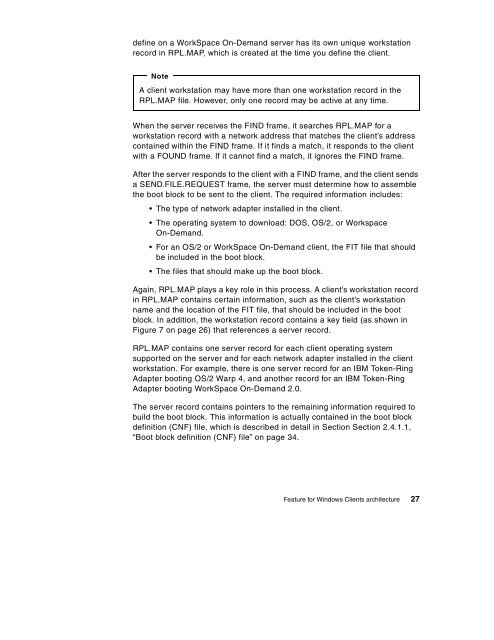WorkSpace On-Demand 2.0 Feature for Windows ... - IBM Redbooks
WorkSpace On-Demand 2.0 Feature for Windows ... - IBM Redbooks
WorkSpace On-Demand 2.0 Feature for Windows ... - IBM Redbooks
You also want an ePaper? Increase the reach of your titles
YUMPU automatically turns print PDFs into web optimized ePapers that Google loves.
define on a <strong>WorkSpace</strong> <strong>On</strong>-<strong>Demand</strong> server has its own unique workstation<br />
record in RPL.MAP, which is created at the time you define the client.<br />
Note<br />
A client workstation may have more than one workstation record in the<br />
RPL.MAP file. However, only one record may be active at any time.<br />
When the server receives the FIND frame, it searches RPL.MAP <strong>for</strong> a<br />
workstation record with a network address that matches the client’s address<br />
contained within the FIND frame. If it finds a match, it responds to the client<br />
with a FOUND frame. If it cannot find a match, it ignores the FIND frame.<br />
After the server responds to the client with a FIND frame, and the client sends<br />
a SEND.FILE.REQUEST frame, the server must determine how to assemble<br />
the boot block to be sent to the client. The required in<strong>for</strong>mation includes:<br />
The type of network adapter installed in the client.<br />
The operating system to download: DOS, OS/2, or Workspace<br />
<strong>On</strong>-<strong>Demand</strong>.<br />
For an OS/2 or <strong>WorkSpace</strong> <strong>On</strong>-<strong>Demand</strong> client, the FIT file that should<br />
be included in the boot block.<br />
The files that should make up the boot block.<br />
Again, RPL.MAP plays a key role in this process. A client’s workstation record<br />
in RPL.MAP contains certain in<strong>for</strong>mation, such as the client’s workstation<br />
name and the location of the FIT file, that should be included in the boot<br />
block. In addition, the workstation record contains a key field (as shown in<br />
Figure 7 on page 26) that references a server record.<br />
RPL.MAP contains one server record <strong>for</strong> each client operating system<br />
supported on the server and <strong>for</strong> each network adapter installed in the client<br />
workstation. For example, there is one server record <strong>for</strong> an <strong>IBM</strong> Token-Ring<br />
Adapter booting OS/2 Warp 4, and another record <strong>for</strong> an <strong>IBM</strong> Token-Ring<br />
Adapter booting <strong>WorkSpace</strong> <strong>On</strong>-<strong>Demand</strong> <strong>2.0</strong>.<br />
The server record contains pointers to the remaining in<strong>for</strong>mation required to<br />
build the boot block. This in<strong>for</strong>mation is actually contained in the boot block<br />
definition (CNF) file, which is described in detail in Section Section 2.4.1.1,<br />
“Boot block definition (CNF) file” on page 34.<br />
<strong>Feature</strong> <strong>for</strong> <strong>Windows</strong> Clients architecture 27

















